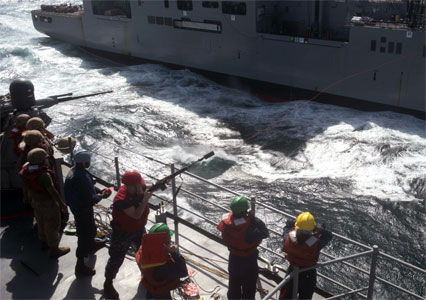Three significant deliveries in the last 12 months — USNS Cesar Chavez, the 14th and final replenishment vessel in the Lewis and Clark class, and USNS Spearhead and USNS Choctaw County, the first two Joint High Speed Vessels (JHSVs) —have underlined the growing number of civilian professional mariners operating vessels in the service of the nation’s defense.
Both classes of vessels are civilian crewed, and the number of civil service mariners employed by the U.S. Navy’s Military Sealift Command has grown steadily by 40 percent over the last 10 years, from 4,026 at the end of fiscal year 2003 to 5,652 at the end of fiscal 2012. Much of that increase is due to the Lewis and Clark class.
A different MSC category — commercial mariners, who work for companies that have operating contracts with the MSC — has dipped over the same period, from 2,118 to 1,738. But that will change.
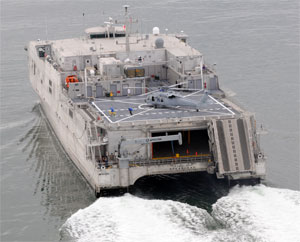 |
|
Courtesy U.S. Navy |
|
USNS Spearhead, the MSC’s first Joint High Speed Vessel, on trials. |
USNS Montford Point, the Navy’s new Mobile Landing Platform, is crewed by commercial mariners under a contract with Ocean Shipholdings, of Houston; its sister vessel, USNS John Glenn, is scheduled for delivery next year. And Frank Randall, an MSC spokesperson, points out that although the first four JHSVs will be crewed by civilian mariners, the follow-on vessels will be operated on commercial contracts.
“It’s a function of the new ships,” Randall said of the changes in personnel numbers. “It’s a supply-and-demand thing that we respond to.”
The intersection of the military and commercial worlds is mirrored in shipbuilding, too. Electric Boat may stick to submarines and Bath Iron Works to destroyers, at least for now, but yards such as General Dynamics Nassco, Marinette Marine, VT Halter Marine, Dakota Creek Industries and Bollinger Shipyards have a mix of commercial and military work. Navy repair work is important too, at shipbuilders such as Nassco, BAE and Vigor Industrial; Nassco in particular has a number of long-term maintenance contracts with Navy as well as spot repair work and is busy at its yards on both coasts.
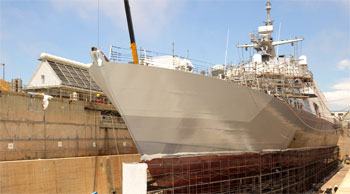 |
|
Courtesy U.S. Navy |
|
USS Fort Worth, a Marinette Marine-built Littoral Combat Ship, sports a new camouflage paint that parts with World War II-era designs. |
Where do these yards stand in an era of sequestration and uncertain budgets? New design contracts still hold the promise of future work. Nassco won an $11.2 million award in June that envisions a fourth MLP, even though the decision to build one has not yet been announced. And Nassco, Huntington Ingalls Industries and VT Halter Marine all have $1.7 million contracts to study affordable designs for the next generation of fleet oilers.
Navy shipbuilding has not gone unscathed. In 2008, Congress approved 18 JHSVs from Austal USA in Mobile, Ala.; that number was reduced to 10. But Joe Carnevale, a retired rear admiral who follows the defense industry for the Shipbuilders Council of America, points out the pitfalls in assuming that any Navy program is dead and buried.
“They still have years of production left and who knows what will happen?” he asked. “Congress has been known to say yes, you want to terminate this program, but no, here’s two more of them, and then here’s two more, year after year.”
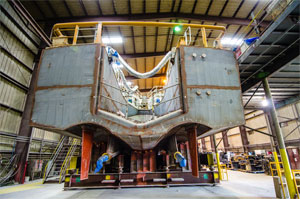 |
|
Brian Gauvin photo |
|
A Fast Response Cutter takes shape at Bollinger Shipyards. |
Generally, Carnevale said, “Congress has been very supportive of both the shipbuilding account and the ship depot maintenance account.” The real danger, he said, is sustained sequestration. “I’ve heard numbers as low as a 220-, 230-ship Navy floated out there. When you’re at 275, 280 ships and needing 306, to say that you’re going to go down to 230 is a dramatic change.”
Building for the U.S. Coast Guard is steady. Huntington Ingalls continues to build National Security Cutters at a cost estimated by the Congressional Research Service at about $684 million each, and Bollinger is delivering a steady stream of 154-foot Fast Response Cutters at about $73 million per boat; the seventh, USCG Charles David Jr., was delivered to Key West, Fla., in August.
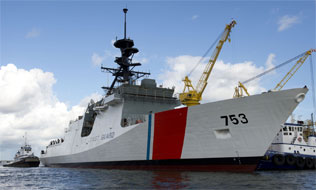 |
|
Courtesy Huntington Ingalls Industries Inc. |
|
Ingalls Shipbuilding launches USCG Hamilton, the fourth National Security Cutter. |
The award that everyone is waiting for is the Offshore Patrol Cutter (OPC) that will replace the Coast Guard’s 210-foot and 270-foot medium-endurance cutters. The service would like 25 of them, and the estimated cost is $484 million per ship. The program has spurred intense competition from at least eight shipyards, some of whom have teamed up with foreign designers — Vigor with Ulstein, for example, and VT Halter with DCNS.
The issue, however, is timing. The Coast Guard wants the next stage in the bidding to involve three competing yards, but no contract awards are now expected until the second quarter of 2014 and the first OPC is not scheduled to be procured until fiscal 2017.
One area that helped many yards during the recent recession was building for foreign customers under the Navy’s Foreign Military Sales program. There’s a risk because of geopolitical tensions; recent customers have included Iraq, Lebanon, Kuwait and Oman. VT Halter Marine is completing an $807 million order for four fast missile craft for Egypt, but Sen. John McCain, R-Ariz., has led a drive to cut off military aid in view of the recent coup in Cairo.

